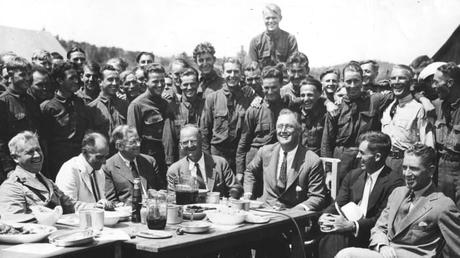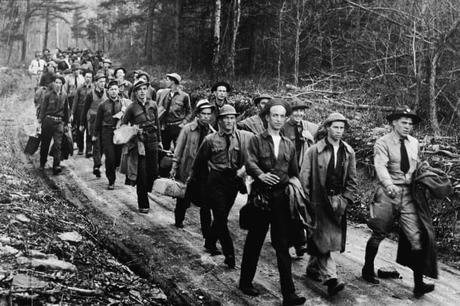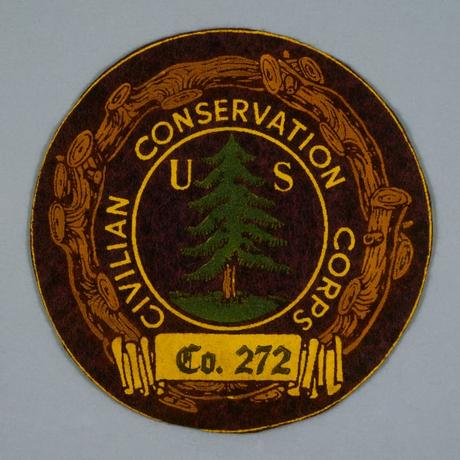When Franklin D. Roosevelt was sworn in as president in 1933, he took the helm of a United States brought to its knees by the Great Depression. With an unemployment rate of up to 25%, millions of people were unemployed and an entire generation of young people had lost hope in their future, many living in makeshift slums and riding the rails like hobos and dinghies.
In its inaugural address, FDR clung to an idea that was already tested in states like California and Pennsylvania - to employ young people as an environmental army of tree planters, firefighters and soil conservationists .
"Our biggest main task is to get people to work," said FDR. "It is not an insoluble problem if we face it with wisdom and courage. This can be accomplished in part by direct recruitment by the government itself, treating the job as we would treat the urgency of a war, but at the same time, through this job, by carrying out projects much needed to stimulate and reorganize the use of our Resources nature. "

PhotoQuest / Getty Images
On March 31, 1933, the FDR signed the federal unemployment relief law, which recruited healthy young single men to join what was to become the Civilian Conservation Corps or CCC. The men, mostly uneducated and untrained, were paid $ 30 a month, of which $ 25 was sent directly to their families. They lived in racially separate camps that operated according to military-style rules, but they had money in their pockets and food in their stomachs.
At its peak in 1935, the CCC enrolled 500,000 men in 2,600 camps across the country. The popular New Deal program was phased out in 1942, the same young enrollees having enlisted for World War II.
In its nine years of existence, the CAC has achieved its dual objective of saving a lost generation and restoring the wasted natural wealth of the country. Here are some of the CAC's accomplishments.
WATCH: 'Bust' from 'America the Story of Us' on HISTORY VaultCCC planted 3.5 billion trees
When FDR was only 19 years old, he was appointed manager of the Roosevelt family's aging estate in Hyde Park, New York. Faced with a serious erosion problem, the young FDR decided to plant thousands of trees. Later, as governor of New York, the FDR led statewide reforestation efforts and purchases of neglected farms to return to productive woodlands.
It is therefore not surprising that reforestation was a major undertaking of the Roosevelt CAC. The United States was once rich in virgin forests, but unrestrained logging had reduced the country's 800 million acres of woodland to just 100 million acres in 1933. Planting trees would not only restore a vital economic resource, but it could fight endemic soil erosion that has contributed to environmental disasters like the Dust Bowl.
Tree planting was so closely associated with the CCC that it was nicknamed "The Roosevelt Tree Army". According to one estimate, assiduous CCC recruits planted 3.5 billion trees from 1933 to 1942, more than half the total number of trees planted in America as part of reforestation efforts.
Not only has the CCC planted billions of new plants, it has also restored and rehabilitated overcrowded forest stands by thinning dead trees. Others registered with the CAC have been accused of maintaining experimental forest plots that have led to innovations in sound forest management.
CAC has created 711 state parks
The Department of the Interior has recruited CCC recruits to help expand national and national park systems. While a number of large national parks existed in 1933 - Yellowstone and Yosemite date back to the 19th century - there were still several states without a single state park, including Virginia, West Virginia, South Carolina , Mississippi and New Mexico.
In the nine years that the CAC has operated, a total of 2 million CAC workers have worked to create new national and state parks and make existing ones more accessible by paving roads, cutting trails and building cabins and campsites. In total, there were 194 CCC work camps in 94 national parks and 697 camps in 881 state and local parks in the United States.
Two well-known national parks were built almost entirely by CCC workers: the Great Smoky Mountains National Park, straddling the border of North Carolina and Tennessee, and the 600-acre Big Bend National Park in the Texas. In addition, the CAC has helped create a total of 711 new state parks across the country.
View of the Civilian Conservation Corps language camp in Bighorn National Forest, Wyoming, circa August 1939. & nbsp;
"data-full-height =" 1373 "data-full-src =" https://www.history.com/.image/c_limit%2Ccs_srgb%2Cfl_progressive%2Ch_2000%2Cq_auto:good%2Cw_2000/MTcyODI5MjUwNzIwNzYcNzyczz -615232108.jpg "data-full-width =" 2000 "data-image-id =" ci0266034cd001272f "data-image-slug =" Civilian-Conservation-Corps-CCC-GettyImages-615232108 "data-public -id =" MTcyODI5MjUwNzIwNzY5NzIy "data-source-name =" Corbis / Getty Images "/> Men from the Civilian Conservation Corps complete a shelter in time for the influx of visitors to the South Mountain Reserve in New Jersey in 1935. & nbsp;
"data-full-height =" 1414 "data-full-src =" https://www.history.com/.image/c_limit%2Ccs_srgb%2Cfl_progressive%2Ch_2000%2Cq_auto:good%2Cw_2000/MTcyODI5MjUwNDUyMjAcMiv -51305464.jpg "data-full-width =" 2000 "data-image-id =" ci0266034a800026ba "data-image-slug =" Civilian-Conservation-Corps-CCC-GettyImages-51305464 "data-public -id =" MTcyODI5MjUwNDUyMjAzMTk0 "data-source-name =" New York Times Co./Getty Images "/> Men from the Reforestation Army, part of the CCC, clear brush from a hill in the St. Joe National Forest and plant seedlings in Idaho.
"data-full-height =" 1595 "data-full-src =" https://www.history.com/.image/c_limit%2Ccs_srgb%2Cfl_progressive%2Ch_2000%2Cq_auto:good%2Cw_2000/MTcyODI5MjUwNDUyMzMc0body -51890981.jpg "data-full-width =" 2000 "data-image-id =" ci0266034b8000272f "data-image-slug =" Civilian-Conservation-Corps-CCC-GettyImages-51890981 "data-public -id =" MTcyODI5MjUwNDUyMzM0MjY2 "data-source-name =" FPG / Getty Images "/> O. W. Shelor teaches 12 CCC trainees in mechanical theory while James J. McEntee (left) looks at the CCC Central Repair Shop at & nbsp; Salem, Virginia on & nbsp; June 5, 1940. & nbsp;
"data-full-height =" 1614 "data-full-src =" https://www.history.com/.image/c_limit%2Ccs_srgb%2Cfl_progressive%2Ch_2000%2Cq_auto:good%2Cw_2000/MTcyODI5MzY5MTAwNjcivODimages -615311860.jpg "data-full-width =" 2000 "data-image-id =" ci026603659000272f "data-image-slug =" Civilian-Conservation-Corps-CCC-GettyImages-615311860 "data-public -id =" MTcyODI5MzY5MTAwNjc0ODYz "data-source-name =" Corbis / Getty Images "/> A man feeds an ice cream cone to a captive cub, serving as a mascot for Camp Strongs Civilian Conservation Corps in the Marquette National Forest, Washington.
"data-full-height =" 1290 "data-full-src =" https://www.history.com/.image/c_limit%2Ccs_srgb%2Cfl_progressive%2Ch_2000%2Cq_auto:good%2Cw_2000/MTcyODI5MjUwNzIwNjMcv body -615230546.jpg "data-full-width =" 2000 "data-image-id =" ci0266034c700026ba "data-image-slug =" Civilian-Conservation-Corps-CCC-GettyImages-615230546 "data-public -id =" MTcyODI5MjUwNzIwNjM4NjUw "data-source-name =" Corbis / Getty Images "/> Civilian Conservation Corps recruits play billiards, circa 1940.
"data-full-height =" 1501 "data-full-src =" https://www.history.com/.image/c_limit%2Ccs_srgb%2Cfl_progressive%2Ch_2000%2Cq_auto:good%2Cw_2000/MTcyODI5MjUwNDUyMjcziv body -50688317.jpg "data-full-width =" 2000 "data-image-id =" ci0266034a400026ba "data-image-slug =" Civilian-Conservation-Corps-CCC-GettyImages-50688317 "data-public -id =" MTcyODI5MjUwNDUyMjAzMzEx "data-source-name =" Herbert Gehr / The LIFE Images Collection / Getty Images "/> A group portrait of workers from the African American Civilian Conservation Corps in an unidentified CCC camp. The CCC camps were kept separate by race.
"data-full-height =" 1587 "data-full-src =" https://www.history.com/.image/c_limit%2Ccs_srgb%2Cfl_progressive%2Ch_2000%2Cq_auto:good%2Cw_2000/MTcyODI5MjUwNzIwOTYcMz body -615231424.jpg "data-full-width =" 2000 "data-image-id =" ci0266034cb000272f "data-image-slug =" Civilian-Conservation-Corps-CCC-GettyImages-615231424 "data-public -id =" MTcyODI5MjUwNzIwOTY2MzMw "data-source-name =" Corbis / Getty Images "/> Reforestation members of the 117th New England Civilian Conservation Corps camp form letters from their organization in Tamworth, New Hampshire, January 17, 1934. & nbsp; The popular New Deal Program was phased out in 1942 as the same young people enlisted for The Second World War.
"data-full-height =" 1341 "data-full-src =" https://www.history.com/.image/c_limit%2Ccs_srgb%2Cfl_progressive%2Ch_2000%2Cq_auto:good%2Cw_2000/MTcyODI5MjUwNDUyMzMcMzz -51305488.jpg "data-full-width =" 2000 "data-image-id =" ci0266034b5000272f "data-image-slug =" Civilian-Conservation-Corps-CCC-GettyImages-51305488 "data-public -id =" MTcyODI5MjUwNDUyMzM0Mzgz "data-source-name =" New York Times Co./Getty Images "/>

CAC spent 6.5 million days fighting fires
In the nine years of the CCC's operation, the annual area of US forest lost to fire has sunk to its lowest level, despite the record number of forest fires reported. This is because tens of thousands of young people registered with the CCC were employed full time or as emergency firefighters.
CAC permanent fire crews patrolled large areas of the forest on foot, by truck, by plane and even by canoe. When a fire broke out, nearby CCC camps were enlisted to attack the fire with everything they had - portable axes and hoes, shovels and saws, and the occasional bulldozer.
In a memorable campaign, loyal CCC firefighters attacked the mysterious underground coal fire near Gillette, Wyoming. The fires, which could send flames 20 feet into the air from exposed coal seams, had been burning for as long as residents could remember. CCC employees smothered some of the fires with sand and dug hot materials, which successfully contained 17 separate fires by 1937.
The total number of hours recorded by CCC firefighters from 1933 to 1942 was the equivalent of 6.5 million days. Tragically, 47 CCC firefighters also lost their lives in the effort.
CCC built more than 3,000 fire watchtowers
Fire prevention is just as important as fighting fires. Hundreds of CCC men have been assigned to improve emergency access to forest land by cutting tens of thousands of kilometers of truck lanes, opening new trails and running countless kilometers of line telephone to facilitate communication between fire-fighting units.
Watchtowers were essential for spotting small fires before they turned into forest fires. CCC employees built over 3,000 of these towers, including the Mount Diablo Lookout stone watchtower outside of San Francisco, offering impressive views of the Cascade and Sierra Nevada mountain ranges .
CCC teams also cleared logs and dead wood in fire-prone areas and cut preventive fire breaks to slow the progression of a potentially disastrous fire. One of the largest of these firebreaks was the Ponderosa Way in northern California, a 600-mile scar separating the dry scrub from the wood-rich forests above.
The CCC also supervised the construction of large water storage and collection basins in order to have a water supply ready to fight future forest fires.

David J. and Janice L. Frent / Corbis / Getty Images
CCC built more than 30,000 miles of terraces
The Soil Conservation Service was second behind the Forest Service for the largest number of CCC camps under its leadership. After decades of inappropriate land use - clearing trees to create more farmland, failing to plant cover crops in fallow fields - and years of drought, erosion threatened much of America's farmland . In 1938, there were over 500 active soil conservation CCC projects in 44 states employing 60,000 young men per year.
CCC workers planted trees to serve as a windbreak and ground anchor. They healed gullies and redirected water to the crops. And they trained farmers in modern soil conservation techniques that would lead to healthier land and higher yields.
One of the CCC's most innovative and effective tools was earthwork on hilly terrain to create level fields with less water runoff. Earthworks were no small task, requiring engineers, surveyors and heavy machinery. During the life of the CAC, over 30,000 miles of terraces have been built and thousands of young CAC workers have acquired technical skills that have served them well in their future careers.
CAC launched the American ski industry
Alpine skiing was not a thing in America in the 1920s. There simply weren't dedicated ski runs, let alone amenities like ski lifts or ski lifts. But thanks to the CCC and an avant-garde forestry official from Vermont, America got its first ski runs in the 1930s.
Perry Merrill, the Vermont state forester, had attended a forestry school in Sweden, where he witnessed the Scandinavian passion for alpine skiing. Merrill dreamed of bringing sport to the rugged hills of his home country, but lacked the resources to cut and clean miles of trails. Until he was appointed in 1933 to head a CCC team of 25 robust men.
Over the next few years, tireless CCC workers have drawn legendary New England trails with names like Stowe, Wildcat, Cannon and Thunderbolt. In the West, CCC employees also cut the first ski runs in Sun Valley, Idaho. The first tow cables were installed in the late 1930s and the Americans fell in love with skiing, largely thanks to the CCC.
